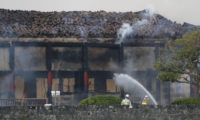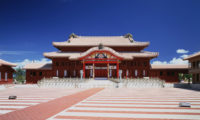 The UNESCO World Heritage site of Shuri castle in Okinawa, Japan, suffered devastating damage in a fire this morning. The castle is of great significance to Okinawa’s cultural heritage in three ways: it was built in the Sanzan Period (14th century) as a castle, was expanded and used as the palace of the king during the Ryukyu Kingdom, and it was rebuilt with meticulous care to historic preservation after it was shelled by US forces during World War II.
The UNESCO World Heritage site of Shuri castle in Okinawa, Japan, suffered devastating damage in a fire this morning. The castle is of great significance to Okinawa’s cultural heritage in three ways: it was built in the Sanzan Period (14th century) as a castle, was expanded and used as the palace of the king during the Ryukyu Kingdom, and it was rebuilt with meticulous care to historic preservation after it was shelled by US forces during World War II.
“The cause of the fire has not been determined yet but a security company alarm went off at around 2.30 in the morning,” Ryo Kochi, a spokesman with the Okinawa prefectural police said.
“It started at the main temple and looks to be spreading fast to all the main structures … firefighters are still battling the fire,” he added.
The fire continued to burn for hours even as firefighters from nearly a dozen engines worked tirelessly to extinguish it. The loss is immense. The Seiden, the main hall, and the Hokuden, the building to the north, the Nanden south of the main hall,and the Bandokoro, the former reception area that is now a museum, were entirely destroyed.
 From 1429 until the end of the Ryukyu Kingdom in 1879, it was the royal court, center of government and foreign trade as well as the king’s residence. The wood structures are susceptible to fire and burned three times over the centuries, in 1453, 1660 and 1709. They were rebuilt.
From 1429 until the end of the Ryukyu Kingdom in 1879, it was the royal court, center of government and foreign trade as well as the king’s residence. The wood structures are susceptible to fire and burned three times over the centuries, in 1453, 1660 and 1709. They were rebuilt.
When Okinawa was taken over by Japan and the kingdom fell in 1879, the castle was used as an army barracks. It was designated a national treasure in 1925, but the Japanese Army used its underground tunnels as a headquarters, so it was deliberately targeted for shelling during the Battle of Okinawa at the end of May 1945. Again the castle caught fire and most of the buildings were lost.
Enough of it was standing by 1950 to house the University of the Ryukyus. Reconstruction of the second main gate was completed in 1958, and a major reconstruction project began in 1992 to restore the main buildings and walls. It was designated a UNESCO World Heritage site in 2000.